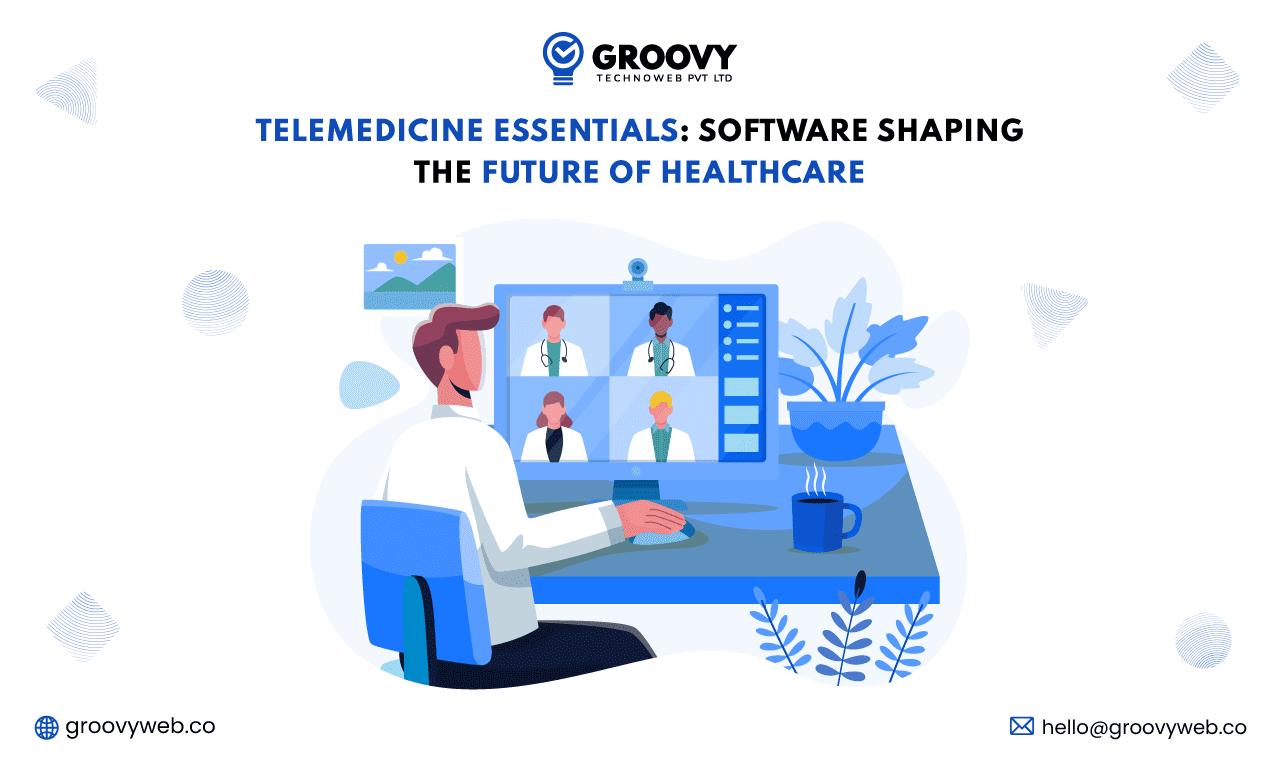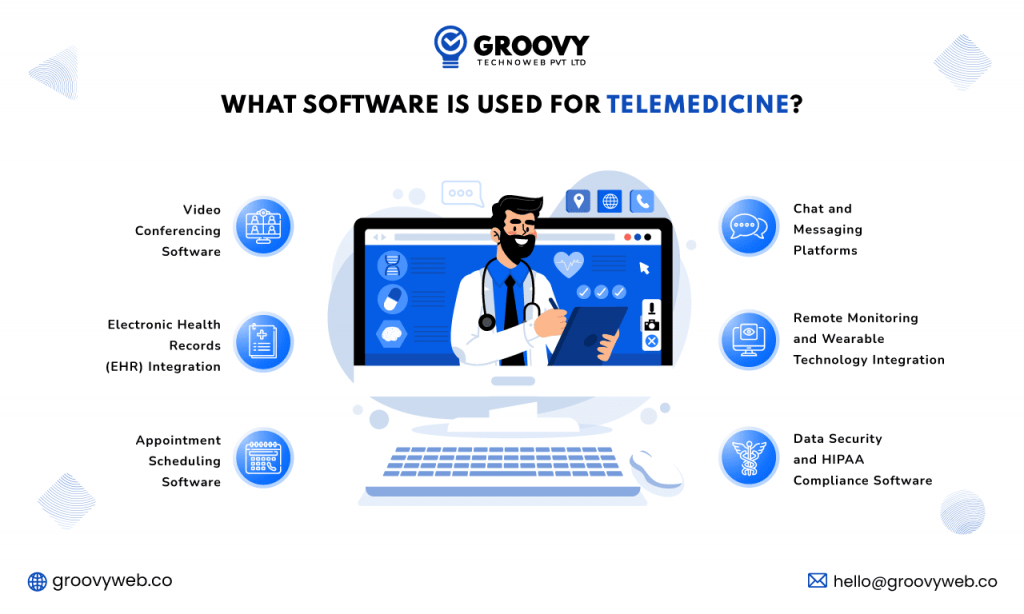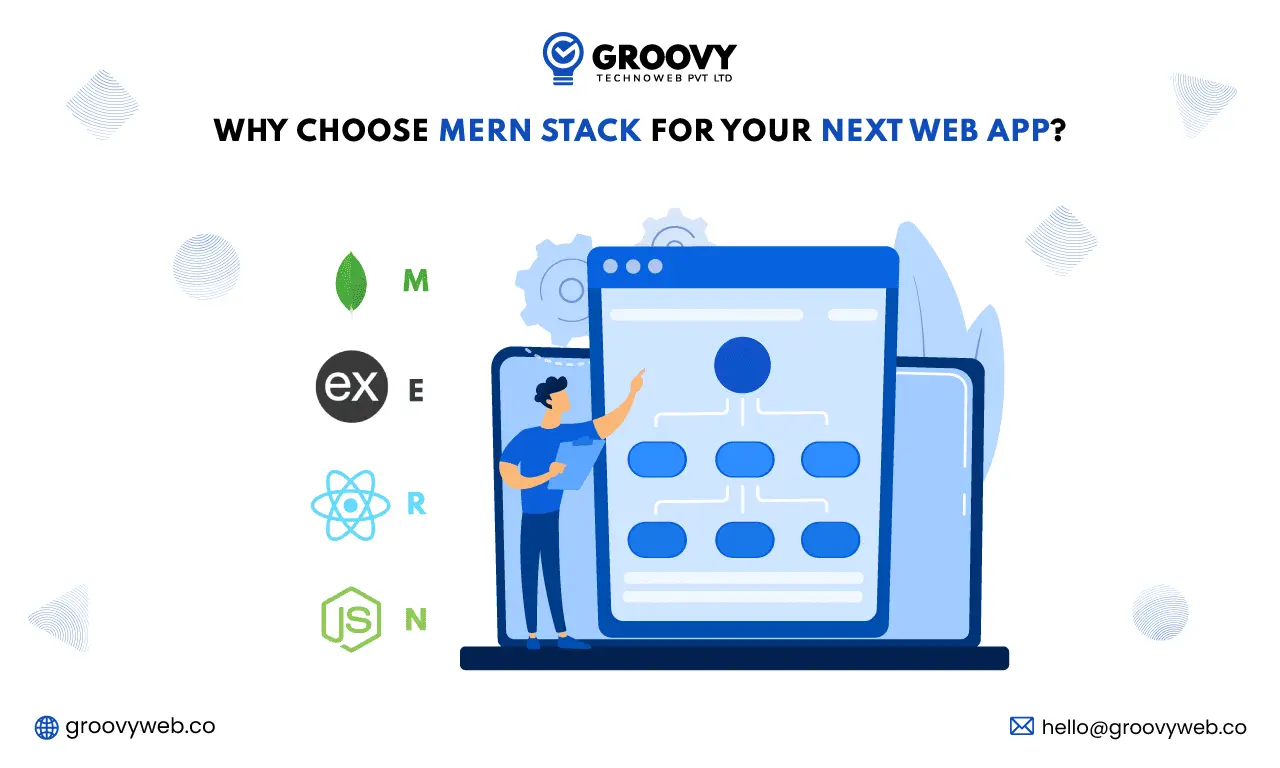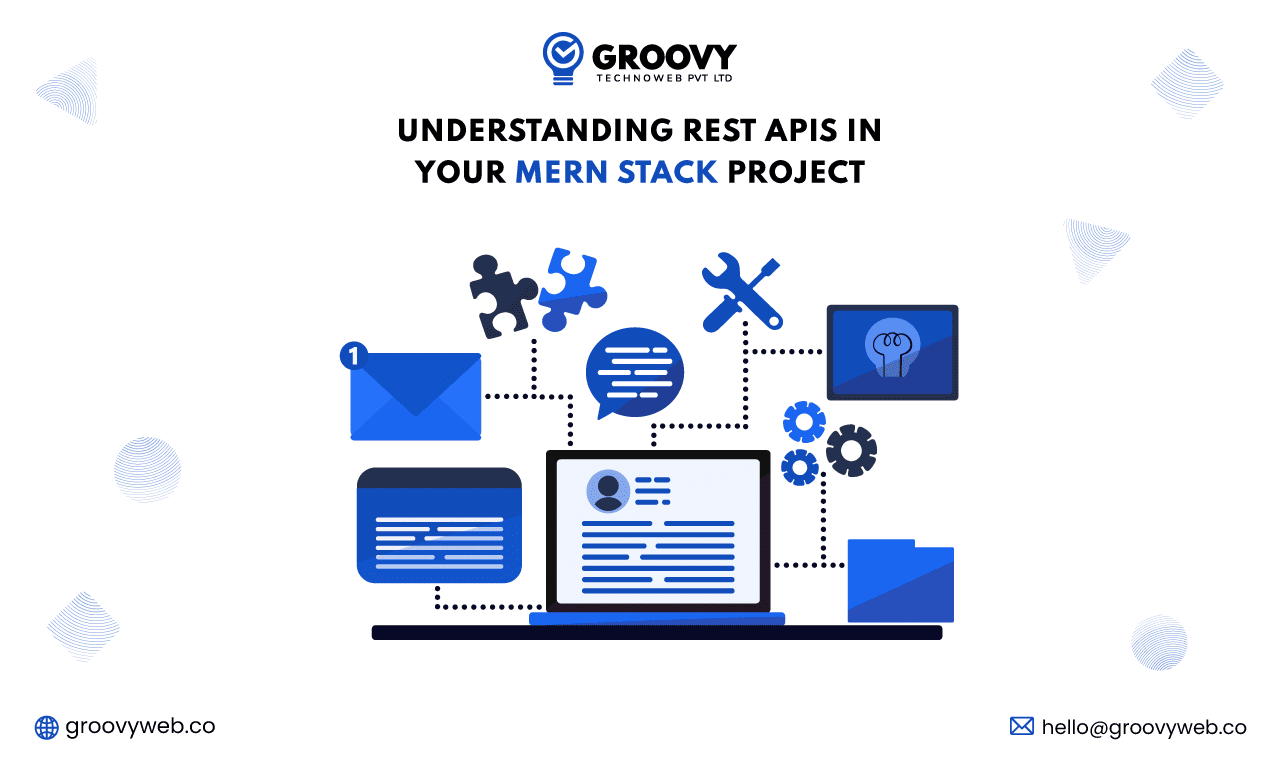Telemedicine Essentials: Software Shaping the Future of Healthcare
Ashok Sachdev
December 05, 2024 173 Views
Quick Summary : This blog will discuss the basics of telemedicine software development ranging from video conferencing feature, up to EHR integration, and security measures. But it stressed that it is necessary to have scalable, user-friendly applications related to healthcare and the importance that HIPAA compliance has in safeguarding patient information. Finally, the blog addresses the development process, like choosing the right technology stack; testing; and finally, launching the app. Groovy Web provides tailored, secure solutions for healthcare providers in having an efficient telemedicine platform.
In recent years, telemedicine software has come of age and changed the face of healthcare all around the world. Its growing usage is now revolutionizing patient-doctor interactions in virtual consultations, remote diagnosis, and telehealth apps. custom telemedicine app development not only provides easier access to healthcare in remote regions but also real-time, convenient solutions for patients and doctors alike.
For telemedicine to succeed, there has to be solid software and technology underpinning its use. From video conference tools to data protection protocols, telemedicine software comes into play, offering health care that is both efficient and safe. This blog delves deep into the main aspects of telemedicine software development, and the software used for telemedicine, and shows you the healthcare app development guide so that you can understand how these technologies shape your healthcare future. Telemedicine has transformed the landscape of health care delivery as it enables the patient to easily access advice, diagnoses, and treatments from anywhere at any convenient time from the comfort of their homes, with video calls, chat, or developed mobile app solutions created through telemedicine software development.
This service is also vital for the patients residing in such remote and scarce areas where healthcare facilities are fewer and inaccessible either far-off or complicated to reach. Where the geographical barrier is removed in healthcare app development to ensure patients can reach a source of care on time rather than waiting hours or traveling for miles. Telemedicine will also expand the access to health care for people who are mobility-impaired, or affected by chronic diseases, and people who need more frequent consultation. Also, it can facilitate real-time communication between patient and caregiver; therefore, making quick decisions, managing prescriptions, and offering after-care may be achieved. In the case of public health emergencies, like the situation of the COVID-19 pandemic, telemedicine plays a critical role in reducing direct contact with the case of a patient and managing their care remotely, thereby alleviating pressure from the healthcare system.
With an increasing demand for more accessible healthcare, the development of telemedicine software is a necessity for securing and scalable platforms. The right software applied to telemedicine must come with high-quality video consultations, secure patient data, and should be able to comfortably integrate into electronic health records. The future of healthcare is increasingly a digital phenomenon, thus not making telemedicine a convenience but the very essence of delivering fair and efficient access to healthcare across the globe.
What is Telemedicine and Why is it Important?
Telemedicine is the remote provision of clinical care via digital platforms. Thus, patients may not go to a hospital or clinic but rather see their provider remotely via video calls, chat, or mobile applications. This technology ensures that healthcare services reach as many people as possible, especially in those areas that are geographically limited and cannot easily access medical facilities.
These are the reasons why telemedicine software development has become a must, especially with more demands on accessible healthcare. A more scalable, secure, and user-friendly platform in such applications has become a driving force to create more advanced healthcare applications responsible for meeting the needs of patients and providers. For a deeper understanding, explore our complete healthcare app development guide to learn how to build scalable and innovative solutions for modern healthcare demands.
What Software is Used for Telemedicine?
Telemedicine relies on the proper harmony of software solutions. Here is a breakdown of the basic software applied for telemedicine that defines this new era in health care:

Video Conferencing Software
Core Functionality
It enables real-time communication between patients and healthcare providers through high-definition video and audio.
Popular Tools
Zoom, WebRTC-based applications, Skype for Business, and Microsoft Teams.
Why It Matters
Video conferencing software that works ensures that consultation goes smoothly and that patients can discuss health conditions, diagnoses, or treatments with doctors in detail without necessarily having to be in the same room.
Electronic Health Records (EHR) Integration
Core Functionality
A digital means of storing and retrieving information of patients, including medical histories, prescriptions, lab results, or imaging.
Popular Tools
Among those listed, are Epic, Cerner, and Athenahealth.
Why it Matters
Telemedicine apps connected to EHR allow providers access to vital patient information in real-time during these virtual consultations, which can be just as informed as an in-person visit.
Appointment Scheduling Software
Core Functionality
Enables patients to book, reschedule, or cancel an appointment to doctor with healthcare professionals.
Popular Tools
Acuity Scheduling, Appointy, and Setmore.
Why It Matters
Convenient scheduling helps ensure access to telemedicine services in a hassle-free, queue-less manner and without delays due to administrative tasks.
Chat and Messaging Platforms
Core Functionality
Secure Messaging Channel enables patients to get text-based real-time communication with healthcare providers.
Popular Tools
Twilio, WhatsApp Business API, and Telegram for business.
Why It Matters
Sometimes, a quick message or chat can resolve simple health concerns. The addition of chat features in telemedicine apps has been proven to enhance patient engagement and communication.
Remote Monitoring and Wearable Technology Integration
Core Functionality
Let the doctor remotely monitor patient vitals and health data from connected devices like wearables.
Popular Tools
Apple Health, Fitbit, and Garmin Connect.
Why It Matters
With remote monitoring, constant tracking of health conditions is possible, and doctors can make interventions and decisions in real-time.
Data Security and HIPAA Compliance Software
Core Functionality
Telemedicine ensures all of its platforms are secure and HIPAA compliant with standards for data protection laws.
Popular Tools
MedStack, Paubox, and TrueVault.
Why It Matters
The essence of patient confidentiality in healthcare determines the position of confidentiality among different providers. Ensuring compliance with and use of secure software during telemedicine consultations will guarantee the security of personal health information.
Telemedicine Software Development: A Comprehensive Healthcare App Development Guide
Creating a perfect telemedicine app demands an understanding of both technical as well as healthcare aspects. Telemedicine software development has only gained more importance in an age where virtual health solutions are increasingly demanded. Quality care of the patient and the overall efficiency of health providers can be guaranteed through a powerful and reliable telemedicine platform. To develop a robust telemedicine solution that copes with modern healthcare demands, below is an easy-to-follow step-by-step healthcare app development guide.
-
Identify Your Core Features
The first step for building an effective telemedicine app would be to define the core features. The right balance of features would make your platform simple, complete, easy to use, and comprehensive for patients as well as healthcare providers. Some of the main functionalities include:
- Patient and Doctor Profiles
Include safe logins for doctors and patients. This way, user data protection will be ensured along with the personalization of each profile with its medical history and treatment records.
- Video and Audio Conferencing
Include integration of seamless communication tools that would allow real-time consultations between patients and health service providers. This feature has to have high-quality video and clear audio so that it mirrors actual in-person visits.
Appointment Scheduling
It needs to be user-friendly so that scheduling, canceling, or rescheduling appointments are conducted efficiently. The use of automated reminders helps minimize no-shows and makes your healthcare practice all the more efficient.
EHR Integration
The telemedicine app needs to integrate seamlessly with EHRs. This way, the doctor can access the patient’s medical records at the point of consultation and provide care differentiated on the basis of historical data.
Prescription Management
It will permit digital prescriptions through the application and enable doctors to prescribe medicines after which can send prescriptions to pharmacies so that it’s easy for patients.
Payment Integration
Secure gateways for payment would also be enabled through the application so that easy payment of teleconsultation fees through credit cards, e-wallets, or other digital payment gateways might be facilitated.
All these features shall be included in the process of developing your telemedicine software, thereby ensuring that the app offers a healthy solution and is easy to use.
-
Choose the Right Technology Stack
The right selection of technology stack plays a crucial role in the scalability, performance, and security of your telemedicine app. Your tech stack must fulfill healthcare app development-specific needs and must be sure about the smooth operations on various devices.
Programming Languages
The popular choice for telemedicine applications includes JavaScript, Swift, Kotlin, and Python. These languages are flexible, suitable for high performance, and ideal when you want to develop iOS and Android app solutions. Additionally, all the above languages support both iOS and Android platforms.
Frameworks
Include cross-platform app development frameworks such as React Native, Flutter, and Angular for superior performance. The frameworks promise faster development cycles while having high performance and offering native-like experiences on any device.
Cloud Infrastructure
It ensures massive volumes of medical data are handled. Currently, cloud storage and processing are critical to any state-of-the-art organization. Top cloud platforms like AWS, Google Cloud, and Microsoft Azure provide high availability, scalability, and data storage that are HIPAA compliant.
Security Technologies
To ensure data privacy and regulations by proper health service, end-to-end encryption, two-factor authentication, and data tokenization.
Therefore, security holds an important key in telemedicine software development since it deals with highly sensitive healthcare data. The right selection of technology helps your telemedicine application to work efficiently with its performance, security, and scalability for growth in the future.
-
Ensure HIPAA and GDPR Compliance
Compliance with healthcare regulatory standards is one aspect that is exceptionally important in telemedicine software development, such as HIPAA in the US or GDPR in Europe. Such compliance ensures that patient data is kept secure, and any breach of compliance could result in heavy fines and reputational damage.
Encryption of Data
All the patient information kept should be encrypted during both transmission and storage at rest so that unauthorized access is prevented.
Access Control
It should have role-based access to limit the access to patient data based only on authorized personnel to reduce the risks of data breaches.
Audit Logging
Comprehensive audit trails of each access and interaction of patient data are maintained to meet regulatory needs.
Here are the best practices that can be used in developing your telemedicine app, not only delivering seamless service but also safeguarding the highest standards of data privacy and security.
-
Create a User-Friendly Interface
If the telemedicine app intends to become a success, then it needs to be extremely user-friendly. The right response from both the patients as well as healthcare providers of an app is such that it becomes intuitive and plain. Bad design on the part of UI may result in frustration, reduce adoption, and cause a drop-off in using the app.
A clean and intuitive navigation design with self-explanatory icons and explicit menus needs to be deployed. Important features such as appointments, medical records, and consultations ought to be accessed easily with a few taps.
Responsive Design
The app needs to look the same way and work similarly on a tablet or smartphone from another manufacturer or model. Responsive design ensures that the quality experience translates well to varying devices and screen sizes, given that both patients and providers may access the app using different devices.
Onboarding and Tutorials
provide a guideline walkthrough of onboarding or in-app tutorials to assist users in understanding how they can navigate and use the application fully.
A good UI design will encourage engagement while making the user journey simple, thus easier for both the patient and the doctor to use the telemedicine platform.
-
Test and Launch
Testing is one of the most important pre-launch phases of your telemedicine application. It aims to check whether the application does not contain any bugs, security holes, or performance problems that need to be sorted before its launch.
Functionality testing
Ensure that all of your features – from video conferencing to EHR integration – work seamlessly across devices and operating systems.
Performance Testing
One merely tests the app’s speed, responsiveness, and scalability, which will be able to carry large volumes of users. Telemedicine software development requires top-notch performance so that consultation and data handling is smooth.
Security Testing
Check that all the security measures are being fully utilized to ensure correct HIPAA and other regulatory compliance. Data encryption, access controls, and audit logs would also need to be tested.
Usability Testing
On-site usability of the app through user testing to find out whether the application is of simple and easy usage, in navigation, or which experience is presented overall. This helps ensure that the interface is friendly to use by both patients and health providers.
With the testing phase over, the application can be rolled out to various platforms such as Android, iOS, or the web. After the application is launched, the application’s performance, user feedback, and engagement metrics are constantly monitored for updates and tweaking the user experience when required.
Why Telemedicine is the Future of Healthcare
Telemedicine software development is indeed changing the face of healthcare delivery to people in the world, making it accessible, efficient, and cost-effective. As in-house healthcare demand keeps rising, this flexible approach has a bridge both between patients and healthcare professionals. Doctors can offer real-time consultations, observe their health conditions from a distance, and manage critical patient information through advanced telemedicine software without physically visiting the doctors. This will be suitable for patients who live in a rural setting or underdeveloped areas and are unlikely to reach any medical facilities.
The further growth of telemedicine is attributed to advances in healthcare app development, especially with essential tools like video conferencing, EHR integration, and secure data management systems. All these features enable healthcare providers to offer personalized quality service to more patients, hence improving the outcome and reducing overhead costs compared to other services. Additionally, understanding healthcare development costs is crucial for creating scalable telemedicine software that enables healthcare systems to cater to their clients’ ever-growing requirements in routine check-ups and specialized treatments.
Telemedicine is at the cutting edge of future-ready solutions for the healthcare industry. Improving patient care, augmenting operational efficiency, and bringing down costs simultaneously are the beauty of telemedicine. Investing in pioneering telemedicine software development ensures that healthcare providers stay ahead of the curve and meet the needs of modern healthcare.
Conclusion
Telemedicine has come with increased momentum, and so has its role for the same. From video conferencing systems to secure and controlled patient data management systems, the required step is the development of telemedicine software for quality health care in a digital age.
Telemedicine software goes miles to expand services and improve patient care among healthcare providers. Following the development guide for the health app, the telemedicine platform adopted went all the way to not only be functional but also secure, scalable, and user-friendly.
As the healthcare landscape continues to evolve, telemedicine is going to be the backbone of this industry in the future, shaping the course of interactions between patients and doctors and the very fabric of delivering health care. No matter how new or old your telemedicine application is, the telemedicine software will be what makes or breaks your success.
Written by: Ashok Sachdev
Ashok Sachdev is the Project Manager at Groovy Web who began his professional career as a programmer at the young age of 17. Ever since then he is actively growing, learning new things, and adapting to new roles and responsibilities at every step. Aside from being an app developer, he is highly admired for his project management skills by his clients.
Frequently Asked Questions
We hope these clear your doubts, but if you still have any questions, then feel free to write us on hello@groovyweb.coHow does telemedicine software help reduce healthcare costs?
Telemedicine decreases overhead expenses further by reducing the amount of space or facility required, streamlining patient care, and axing travel for both the patients and providers. Providers can then optimize their resources to reach a larger number of patients without increasing overhead expenses for infrastructure because of remote monitoring and virtual consultations that integrate these technologies for telemedicine.
How does Groovy Web support telemedicine software development?
Groovy Web specializes in scalable and secure telemedicine software solutions for your specific needs. From intuitive interfaces for patients to compliance with data security standards like HIPAA, Groovy Web makes sure that your telemedicine platform will be user-friendly and properly compliant with all industry regulations.
Why should I invest in telemedicine software development?
Telemedicine software development investment allows healthcare providers to reach more patients, provide more flexible care options, and reduce operational costs. As health trends shift to remote care, a secure, scalable telemedicine platform can give providers added competition and effectiveness in patient outcomes.
Why choose Groovy Web for telemedicine app development?
Groovy Web has great expertise in medical application development and designs customized applications for the specific needs of healthcare providers or organizations. Groovy Web makes sure that your telemedicine app is equipped with all the features to provide quality patient care while ensuring safety on the data side.
Related Blog

Nauman Pathan
Why Choose MERN Stack for Your Next Web App?
Web App Development 08 Jan 2025 10 min read
Kartik Bhaviyash
Passionately Creating Promising App Solutions Endows Groovy Web to Become One of the Most Sought-After Firms: GoodFirms
News 13 Nov 2024 4 min readSign up for the free Newsletter
For exclusive strategies not found on the blog
